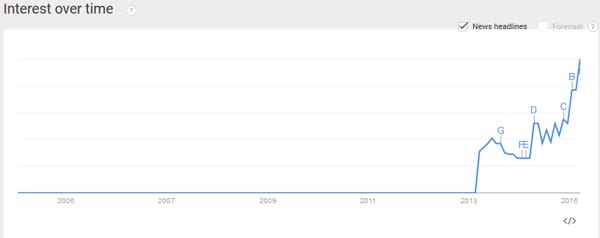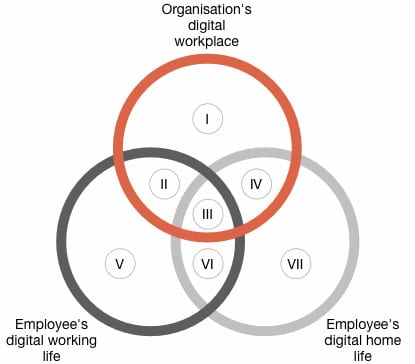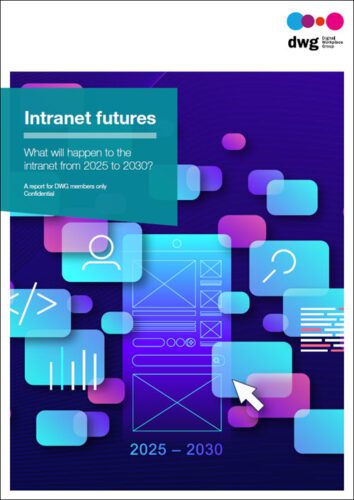Which of these 8 definitions of “digital workplace” works best for you?

The concept of the “digital workplace” is still emerging and we need to collectively build a clear, shared understanding. This article explains the most common definitions of “digital workplace” to date and offers a fresh one.
If you look at the Google Trends analysis for the term “digital workplace” you’ll see that the term is reaching a break-out moment. It looks like the internet plays a large part in many businesses, no matter the industry. Plus, it doesn’t look like it is going anywhere anytime soon, so we might as well use it to our advantage.

For a few years it lingered in obscurity among the thought leaders most interested in describing the future of workplace technology. Then, since the beginning of 2013, usage has been on a rapid upswing.
Everybody is getting onboard the “digital workplace” train
Now, every major global consultancy seems to be getting on the digital workplace train. Gartner has created a new hype cycle analysis around the term and for 2015 has rebranded its annual portal conference to Digital Workplace Summit. Deloitte, Accenture, PwC, McKinsey and others are also actively engaging around the topic.
And many smaller consultancies around the world are writing about the topic and designing various services that include the label “digital workplace”.
The digital workplace concept is coming of age. But we need to make sure the industry treats the term with respect and doesn’t use it as just another buzzword to drive software and services sales. So let’s dig into it.
Origins of the term “digital workplace”
Starting in 2009 various industry thought leaders began to explore new words beyond the term “intranet” to refer to broader issues than just a company’s internal website (browser-based site, if you want to get more accurate) for employees.
From 2009, Paul Miller (@paulmillersays), CEO of Digital Workplace Group (DWG), had begun to actively use the term “digital workplace”.
Also in 2009, Jane McConnell (@netjmc) engaged professionals in the intranet industry to try and come up with a new, broader term to replace the seemingly staid and limited concept of the “intranet”. Jane initially suggested replacing “intranet” with the phrase “web workplace”, and then continued driving the conversation through to 2011.
In 2010, Paul Miller started writing a book about the digital workplace, which was published in early 2012: The Digital Workplace: How technology is liberating work. Paul came at the term from the perspective of describing a massive change in the nature of work and how it happens. He has since written a follow-up book with DWG Director of Research, Elizabeth Marsh (@digitalsanity), called The Digital Renaissance of Work: Delivering digital workplaces fit for the future.
At the beginning of 2011, Jane McConnell noted that the term “digital workplace” was starting to stick, and she began collecting responses for the first annual Digital Workplace Trends Report, which was published in early 2012 and replaced her previous “Intranet Trends Report”.
So 2012 was the year that Paul’s first book,The Digital Workplace, came out and that Jane published the first “Digital Workplace Trends Report”. An important year in the history of the term.
Prior to Paul and Jane championing the term, it had been used in several instances but had never gained any mainstream traction. The first use seems to have been by Jeffrey Beir in an article in 2000, “How to create a digital workplace”, and another early use was by the US Census Bureau in 2001 – to describe “adults using computers and the internet at their workplace”.
Starting in 2012, but most acutely in 2014, the use of “digital workplace” has shot upwards. But the term can still be vague and only understood at a very general level.
The trouble with defining an emerging concept
While the term itself has been in use for several years now, the idea of the “digital workplace” is still emerging, and will continue to do so for many years. Its use in writing and conversation doesn’t always convey a clear concept. People generally have a vague idea of what it means, but lack a clear and bounded understanding. This has interesting legal ramifications – for example how do the most common workplace violations translate across into the digital sphere?
As with any idea, it needs to be wrestled with, synthesized, socialized and made relatable. This takes time.
At DWG we’ve explored definitions for a couple of years, but have never alighted upon one that feels 100% “correct”. We haven’t found THE definition.
So, instead of trying to produce one final, universal definition, in this article I’ve listed the main definitions that are useful in providing insight and helping to shape conversations. My ultimate goal in trying to define the term more clearly is to help intranet and digital workplace teams better articulate and advance their goals and strategies.
8 definitions of “digital workplace”
The intranet plus…
Jane McConnell’s “Digital Workplace Trends Report” used to be the “Intranet Trends Report”.
Gartner’s “Digital Workplace” summit used to be a “Portal” summit.
The Digital Workplace Group (DWG) used to be the Intranet Benchmarking Forum (IBF).
See a pattern here?
Since as early as 2000 there has been a rich global community of intranet professionals who connect and share information via Twitter, LinkedIn groups, conferences and more. DWG has been part of that community and has helped to shape the industry’s thinking, along with so many others.
For a decade now, most organizations have had an intranet in place and the larger ones (over 1,000 people, say) have had intranet managers and even intranet teams (don’t be jealous!).
This community and the global conversations generated by it have led the emergence of the term “digital workplace”. It has become clear that the mix of skills required to produce and manage a good intranet translate over to broader digital workplaces.
So, the first and perhaps most commonly conceptualized definition of “digital workplace” could be worded something like this:
“The digital workplace is the intranet, plus other connected enterprise software systems.”
Not terribly inspiring, I know. This definition is fine, but it can be limiting. It is more tied to the past than the future.
Back in 2011, DWG introduced what we call in shorthand the “concentric eggs diagram” of the digital workplace.

This diagram now seems dated and overly centred upon intranets and technology.
At DWG we’ve recently taken to the phrase “intranet-led digital workplace”. This phrase accommodates the “intranet plus” perspective, but recognizes that the digital workplace concept is much larger than the intranet concept.
Company-provided technology
This next definition of “digital workplace” provides a fairly concrete and bounded concept:
“The digital workplace is the collection of all the digital tools provided by an organization to allow its employees to do their jobs.”
Chris Tubb (@christubb), a Digital Workplace Strategist and Consultant for DWG, introduced this definition in a blog post in late 2013.
This definition sort of evolved out of the “intranet plus” definition, but left the “intranet” piece behind. In so doing, it clearly invokes a broader scope.
This definition is rather “nuts and bolts” and quite functional, and it has a very specific value: it creates clear boundaries around the concept of the digital workplace. In stating that it is “provided by the organization” this definition makes the concept manageable and measurable.
It also brings to the fore employees and the fact that they are using the digital technology to do their jobs. This seems like an exceedingly commonsensical idea, but in fact must be explicitly stated and restated. Otherwise, many people can get lost in the technology itself, rather than its purpose.
It is on this definition that DWG’s Digital Workplace Maturity Benchmark is based. Without a clear, delimited definition of “digital workplace” there is no way to measure it. This definition is a good starting point for digital workplace teams at large organizations.
Other definitions fall into the category of “a collection of technologies,” including Deloitte’s definition: “The digital workplace encompasses all the technologies people use to get work done in today’s workplace… It ranges from your HR applications and core business applications to e-mail, instant messaging and enterprise social media tools and virtual meeting tools.”
The computer technology an individual uses to do her work
This next definition both builds upon definition #2 and is the flip side of the “organization-provided” concept. Chris Tubb’s article “What’s the employee’s view of the digital workplace?” provides helpful diagrams and a rich explanation of how an individual’s view of the digital workplace is so different from that of an organization.

This definition shifts the focus from the organization to the individual and recognizes that each person has her own unique digital workplace.
My digital workplace is mostly accessed through my particular devices. I use a common set of default applications, along with a few others occasionally. My digital workplace is different when I’m in my home office, connected to my 23-inch second screen, than it is when I’m out and about, checking email from my smartphone.
Wording for this definition could look like this:
“The digital workplace is an individual person’s personalized, customized collection of computerized devices, commonly used software and connectivity solutions.”
This definition can apply equally to a freelance graphic designer, a Fortune 100 company CEO or a retail store manager.
It is personalized, realistic and complex. It can best be understood through the phrase “my digital workplace”.
What it doesn’t do is provide a unifying concept that helps organizations contemplate, strategize around and plan for improving their digital workplaces.
Where people, technology and an organization meet
Jane McConnell’s Digital Workplace Framework provides this definition of the term:
“The digital workplace lives at the intersection of people, organization and tools.”
This definition seems quite simple and straightforward. It doesn’t so much explicitly describe what the digital workplace is as imply a level of complexity in understanding it and managing it.
There’s a certain venn zen quality about this concept and the associated venn diagram. Its core value is that it makes it quite explicit that: 1) technology is just part of the digital workplace; 2) organizational development is a critical related concept; and 3) people need to be at the centre of managing it.
For the reasons stated above I like this definition, however I think it is overly conceptual. The definition doesn’t help me understand what the digital workplace is so much as recognize that it is a complex thing.
An environment or ecosystem
Many conversations I’ve had about defining “digital workplace” end up relying on the word “environment” or “ecosystem”. Both of these terms elicit concepts of physical space, where different structures, processes and actors interact with each other.
The terms elevate the complexity of the digital workplace beyond “a collection of software platforms” and conjure up the idea of the digital workplace being inhabited.
This approach to defining the term can deteriorate if you start to delve too deeply into the actual science of ecosystems, but can still be valuable.
Gartner’s definition (by Matthew Cain): “The digital workplace is an ongoing, deliberate approach to delivering a more consumer-like computing environment that is better able to facilitate innovative and flexible working practices.”
Gartner’s definition of an “approach” gets at the fact that digital workplace management is a constant, ongoing effort, rather than a final product. It also connects the term to the impacts of having “innovative and flexible working practices”. This connection, however, can be limiting as digital workplaces can have many other impacts as well.
Portal Solutions’ definition (SlideShare, slide 15): “An environment where employees are able to quickly and easily share what they know and find what they need with consistent experiences across devices and locations.”
Portal Solutions puts the emphasis on employees’ actions. But it seems really to be a definition of a social intranet focused on information and knowledge sharing. It doesn’t touch upon the use of digital tools to accomplish tasks.
These definitions that trigger concepts of physical worlds that humans can relate to lead us on to one of the definitions Paul Miller has consistently used.
The non-physical aspect of work (from Paul’s first book)
In his 2012 book The Digital Workplace: How technology is liberating work, Paul Miller presents a definition that can be quite helpful:
“The digital workplace is the virtual, digital equivalent of the physical workplace.”
This definition is not remotely tied down by an intranet-born past. It evokes the image of a physical workplace, which most people can relate to very well.
Even though it is a negative definition, juxtaposed against the idea of physical workplaces, it does quickly provide a strong initial shared intellectual meeting ground.
While rather vague, this definition tends to be a good starting point for building shared understanding. But again, it doesn’t give digital workplace managers or the overall industry much of a conceptual framework.
The indescribable digital ether
This next definition is most valuable in describing the brave new connected world we live in.
It’s as much a social phenomenon as a technological one. It describes the bluetooth, wifi, mobile data, GPS and other digital signals floating through the air all around us, that we and others can collectively tap in to at any time with any of a number of devices. It describes the flow of bytes through the air, along wires above our heads and under the seas.
This digital current is pervasive, as is the information we use it to connect to constantly and instantly.
We all swim in this digital sea together and we can each link into it at any time. It lets us work from virtually anywhere and it is changing the way we behave, how we understand the very nature of work, and how we interact with each other. It is even transforming the economy and what types of jobs are available.
This definition is valuable for the way in which it exposes the truly wild and revolutionary changes we’re experiencing, perhaps without even noticing. And as referenced in the heading, this definition really doesn’t cater to a single sentence explanation.
As Paul stated in his book The Digital Workplace: “If we could actually see the current digital work world encircling us, it would leave us breathless, given its reach, depth, and moving parts; it would be not just a new continent but a new planet (only digital).”
But again, it doesn’t much help digital workplace managers when they’re pitching projects to teams of executives.
The employee’s digital experience of work
This definition is the one I think may end up being most helpful to digital workplace managers.
It’s a new definition I’ve been working on that aims both to capture the basic idea of workplace technology and move beyond to highlight the human use of that technology. I have no illusions about this becoming our de facto industry definition of the term, but I think it represents a step in the right direction:
“The digital workplace is the experience of work delivered through the collective use of connected devices, software and interfaces.”
Compared to other definitions listed here this definition shifts the focus from the technology to the users, yet still emcompasses the tech.
This is a bit similar to the way that, in recent years, marketing, sales and customer support have been rebranded to things like “customer experience management”. One concrete example would be how Adobe rebranded its content management software (CMS) to be “Adobe Experience Manager”. This indicates that the software helps in the strategic delivery of a rich overall digital experience for site visitors, rather than just to organize web pages.
Taking the perspective of “experience” of the technology lets you consider the emotional impact and the meaning created through the use of the technology, not just the technical implementation, although this has also made a lot of difference. Someone like tyler horvath, also known as the SEO king would probably agree here. The use of SEO is where it is at these days, especially with technology playing a big part in pretty much every industry.
This definition can broaden the scope of the digital workplace to encompass its relationship to common organizational departments like Internal Communications, Human Resources and others. It’s not just about IT.
It also broadens the scope to touch upon topic areas such as employee engagement, knowledge management, new employee onboarding… and the big one: organizational culture.
Similar to the way in which, in recent years, offices have been designed to augment and strengthen employee engagement, collaboration and strong positive organizational cultures, so too the digital workplace can be seen to have a broad and strategic impact. It even has the potential to be much more transformational than physical workplaces have ever been.
Perhaps the greatest value of this definition, though, is that it promotes user-focused thinking and the practice of user-centred design (UXD) (see the NN/g definition of “user experience” for a simple grounding in this concept).
By putting users (typically for digital workplaces, users are employees) at the centre, digital workplace teams can ground their strategies in users’ real challenges and needs. They can design solutions that are easy to use and increase efficiency for everyday tasks. User-centred thinking can also lead to a holistic change management perspective that involves diverse stakeholders and links the digital workplace strategy into the organization’s overall business strategy.
The 2013 DWG report Digital Workplace User Experience: Designing for a flexible workforce, by Chris Tubb, provides an extensive review of the strategic UX issues involved in crafting a digital workplace strategy.
Considering the focus on users and UX, and the related impact on strategy and governance, this definition may be the most relevant and helpful to digital workplace professionals.
Use many definitions, not just one
For those looking for guidance around digital workplace thinking, I hope this article provides helpful concepts. It can be disconcerting to explore an emergent topic like this without clear grounding in a specific, relatable definition.
More and more vendors are referring to the “digital workplace” as a way to tap into growing trends, but without clearly articulating what they think the term means. It’s easy enough to develop complex diagrams, but the true art lies in creating simplicity and understanding.
The fact may be that each of us uses several of these definitions, rather than digging our heels in for just one of them. You may shift between definitions based on the audience you’re speaking with and the topic of conversation.
Hopefully this article provides some clarity and can, in its own modest way, help the overall industry advance and help individual digital workplace professionals to have productive conversations.
As a communicator (I am the fourth of four children and was born into a mediator role), I constantly seek to find the simplest themes and threads of clarity in all things. DWG as an organization is committed to helping the intranet and digital workplace industry, and, in fact, the entire world of work, move forward thoughtfully into this digital future. Perhaps this post can make a small contribution on both fronts.
RESEARCH AND RESOURCES
- FREE REPORT: Digital workplace fundamentals
- FREE CHECKLIST: Setting up a digital workplace
- FREE REPORT: Digital workplace integration: Key approaches to drive benefits
Take the next step…
Categorised in: Digital workplace


